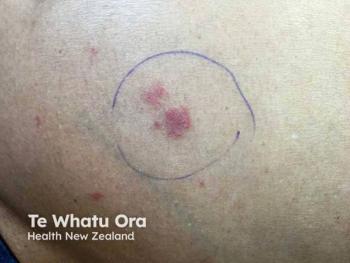
Shared Decision-making in the Management of Atopic Dermatitis
Involving patients with atopic dermatitis in decisions about developing their treatment plan can lead to improved treatment outcomes and higher satisfaction, the American College of Allergy, Asthma & Immunology (ACAAI) medical director said in a luncheon presentation at the college’s 2021 Annual Scientific Symposium.
There are several safe and effective treatment options currently available for patients with moderate to severe atopic dermatitis (AD) and in today’s age of personalized medicine, clinicians should encourage their patients to play a larger role in their treatment and management decisions, according to Michael Blaiss, MD, FACAAI, in his presentation at the American College of Allergy, Asthma & Immunology (ACAAI) 2021 annual scientific meeting held November 4-8, in New Orleans, Louisiana, and virtual.1
Shared decision-making (SDM) is a vital part of the doctor-patient consult and is slowly becoming a more appreciated and used part of the medical practice, empowering patients to be more involved in the, at times, complicated treatment course decision-making process.
“I firmly believe that shared decision-making is vital because there is no one ideal treatment for every patient with moderate to severe AD,” said Blaiss. “Especially as we soon may get more treatments approved in the next year or 2, there will be a lot of excellent treatment options out there. Patients should know the benefits, risks, and costs in helping to decide what may be in fact the best treatment for their particular condition.”
Although many physicians claim that they regularly practice SDM with their patients, this may not be the case, said Blaiss, who is clinical professor of pediatrics and medicine at the University of Tennessee in Memphis, and executive medical director of ACAAI.
Blaiss discussed a recent study1 performed in the Netherlands found that there was a disconnect between physicians who said they used SDM in the vast majority of cases, and the patients themselves who said it was much lower.
“Unfortunately, I do not think that SDM is done very robust in the medical practice and patients often do not realize that it should be,” Blaiss said. “Moreover, most physicians taking care of patients with AD likely are not using any patient decision making aids to help in SDM either.”
Blaiss reminded physicians that some patients actively want to be involved in the treatment decision making process. Patients can easily educate themselves via the internet, Blaiss said, however not all information can be trusted.
Shared decision-making can positively impact a patient’s quality of life and improve treatment outcomes because patients are more directly involved and empowered in the course of their disease treatment and management.
According to Blaiss, if patients are more involved, they tend to more committed to following the therapy, resulting in better adherence and improved treatment outcomes, and higher satisfaction for patients.
To help address patient concerns, he recommended directing patients to ACAAI’s patient decision aid tool for AD. Physicians can use this with their patients to help them understand the differences in treatment options in a language that they can understand. Physicians should be wary to use lay terms, Blaiss said, to ensure that patients understand the discourse surrounding the treatment and management of their condition.
But not all patients want to take an active role, Blaiss said, and prefer to put the decision-making on the physician and follow their advice.
“What we have to do as physicians is offer and invite the patient to do SDM and let them have a say and a choice in a friendly and candid discussion,” Blaiss said. “Shared decision-making should be a standard approach in the management of patients with AD and physicians need to understand how this approach can positively impact the treatment and management outcomes of AD in their patients.”
Disclosures:
Blaiss reported no relevant disclosures.
Reference:
1. Blaiss M. Shared decision-making in the management of moderate to severe atopic dermatitis. Presented at: American College of Allergy, Asthma & Immunology 2021 Annual Scientific Symposium; November 4 to 8, 2021; New Orleans, LA, and virtual.
Newsletter
Like what you’re reading? Subscribe to Dermatology Times for weekly updates on therapies, innovations, and real-world practice tips.


















